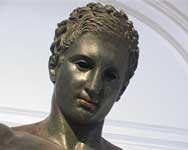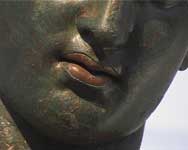.
Griechische Kunst
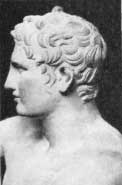
Apoxyomenos, Vatican Museum
Lysippus as we have said was a most prolific artist and made more statues than any other sculptor, among them the Man using a Body-scraper which Marcus Agrippa gave to be set up in front of his Warm Baths and of which the emperor Tiberius was remarkably fond. Tiberius, although at the beginning of his principate he kept some control of himself, in this case could not resist the temptation, and had the statue removed to his bedchamber, putting another one in its place at the baths; but the public were so obstinately opposed to this that they raised an outcry at the theatre, shouting 'Give us back the Apoxyomenos'--and the Emperor, although he had fallen quite in love with the statue, had to restore it. Pliny the Elder, Natural History
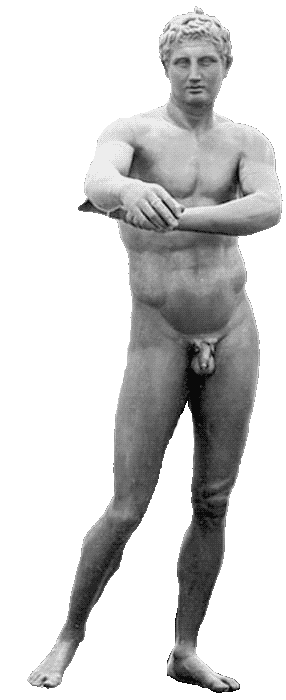
Lysippos (or Lysippus), Apoxyomenos, Roman marble copy of an original dating from c. 330/320 BC, found 1849 in the Trastevere district of Rome. The original bronze statue did not have the tree trunk behind the left leg that was included in the Roman copy. The leaf is a ridiculous censorship from the Vatican. It is possible that the original bronze has been found in 1999 in the sea close to Lošinj, a Croatian island. If we believe Pliny then Lysippos of Sikyon produced around 1500 statues. For the Apoxyomenos the ratio head/body size is 1/8 and not 1/7 as the Doryphoros.
The Probably Original Face of the Apoxyomenos Bronze found in Croatia!
The original Apoxyomenos with a probably different pose than the Roman copy
Restoration Images (Croatian Website)
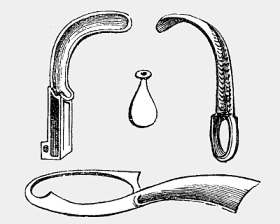
Athletes used to cover their body with oil that they scrapped off (apoxyo) with a bronze scraper (strigil).
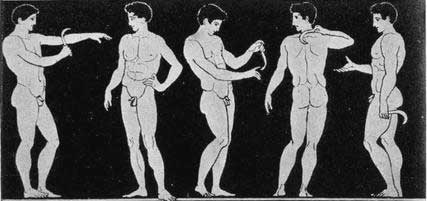
Athletes using the strigil, British Museum Kylix, N0.E83.
The Discovery of the Apoxyomenos in Croatia?
Athlete's toilet set
Athletes bathing
Lysippos Created, a film about the work of Lysippos “2300 years ago, a humble artisan from Sikyon in the Peloponnese, created works of art from bronze that depicted the flowing moment of the human personality within the irripeatable passing of time. “
| Ancient Greece
Science, Technology , Medicine , Warfare, , Biographies , Life , Cities/Places/Maps , Arts , Literature , Philosophy ,Olympics, Mythology , History , Images Medieval Greece / Byzantine Empire Science, Technology, Arts, , Warfare , Literature, Biographies, Icons, History Modern Greece Cities, Islands, Regions, Fauna/Flora ,Biographies , History , Warfare, Science/Technology, Literature, Music , Arts , Film/Actors , Sport , Fashion --- |





